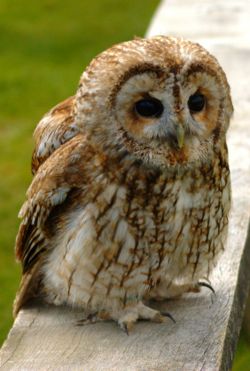Tawny Owl
2007 Schools Wikipedia Selection. Related subjects: Birds
| iTawny Owl | ||||||||||||||
|---|---|---|---|---|---|---|---|---|---|---|---|---|---|---|
 |
||||||||||||||
|
|
||||||||||||||
 Least Concern (LC) |
||||||||||||||
| Scientific classification | ||||||||||||||
|
||||||||||||||
|
|
||||||||||||||
| Strix aluco Linnaeus, 1758 |
The Tawny Owl (Strix aluco) is a species of owl resident in much of Europe and southern Russia.
This species is a part of the larger grouping of owls known as typical owls, Strigidae, which contains most species of owl. The other grouping is the barn owls, Tytonidae.
This is a medium-sized earless owl, 37-43 cm in length with a 81-96 cm wingspan. It is capable of killing prey such as Brown Rats. It is largely nocturnal and very sedentary.
The Tawny Owl is found in deciduous and mixed forests and usually nests in holes in trees. Smaller woodland owls such as the Little Owl and the Long-eared Owl cannot usually co-exist with the stronger Tawny, and are found in different habitats. However, in Ireland, where there are no Tawnies, the Long-eared Owl is found in all suitable woodland.
This species is stocky with a large rounded head and rounded wings. It occurs in two colour phases, rufous brown and greyish brown, with all intermediate forms. The pale underparts are streaked with brown and the facial disc is rather plain. The eyes are black. The Tawny Owl has a strong direct flight.
This species probably injures more people than any other European bird. It is fearless in defence of its nest and young, and strikes for the intruders face with its sharp talons. Since its flight is silent, at night in particular it may not be detected until too late.
The call of the Tawny Owl is the tu-whit tu-whoo immortalised by William Shakespeare. However, it is known today that this call is actually a compound of two calls; the quavering hoo-hoo-hoo by the male and the reply of kew-wick from the female.
The Tawny Owl is believed to have the best developed eyes of all owls. Its retina has about 56,000 light-sensitive rods per square millimeter, enabling it to pick out prey several meters away by the light of one candle over 500 meters away. In low-level light conditions, this is about 100 times better than the eyes of humans.
Hume's Owl, Strix butleri was formerly sometimes considered to be a subspecies of Tawny Owl, but is now classed as a separate species.